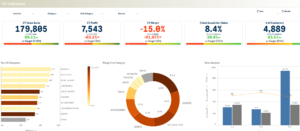
Shopping malls serve as vibrant hubs of commercial activity, attracting a diverse spectrum of visitors with distinct preferences and behaviors. However, traditional marketing approaches often struggle to effectively engage this heterogeneous audience. Advanced data analytics solutions present a transformative avenue, offering profound insights into shopper dynamics and preferences, thereby revolutionizing mall Analytics strategies.
Advanced analytics, in particular, has the potential to revolutionize almost all areas of the mall business. Unfortunately, many mall operators lag behind their tenants when it comes to using advanced analytics. One oft-cited explanation is that malls haven’t traditionally interacted directly with consumers, so they don’t have much consumer data to analyze. But we’ve found that malls already have access to significant amounts of data, including data on shopper behavior, tenant sales, and category performance. What they don’t typically have are the analytical skills and tools to generate insights from the data. Most mall operators still make decisions based on tradition, experience, or intuition—thereby leaving value on the table.
That said, a handful of forward-thinking malls are leading the way in advanced analytics. They’re using prescriptive and predictive analytics—built into user-friendly tools with strong data-visualization capabilities—to make smarter business decisions. In this article, we home in on how malls are using advanced analytics in an especially critical part of their business: revenue management. They’re determining the best mix of stores, understanding and planning store adjacencies that drive higher consumer spending and longer mall visits, and engaging in more-informed rent negotiations with tenants. It’s paying off: malls using these tools have increased their leasing revenues by double-digit percentages.
Assembling the optimal mix of stores:
Most mall operators decide opportunistically which tenants to lease to and which units within the mall each store will occupy. Some malls have a basic tenant-category segmentation but lack a systematic and analytical approach to prioritizing, prospecting for, and acquiring tenants. They don’t have a data-driven way of answering important questions, such as: What types of stores best attract consumers who live or work in the mall’s catchment area? Are my anchor stores driving foot traffic and sales into my mall? Which tenants are unexpected “spend engines” (that is, tenants that are driving cross-conversion and thus creating value despite their own low sales performance)? Which combinations of stores or categories yield the highest collective mall sales?
A mall owner in Asia uses an advanced-analytics tool that crunches sales data and transaction-level data to reveal typical walking routes within the mall and patterns of cross-conversion between categories. The tool quantifies how each store affects overall consumer spending at the mall. In other words, it examines the performance of each store as a spend engine: it shows whether and how much a particular tenant’s presence increases or decreases sales at other stores and whether consumers are likely to shop at certain groups of stores during a single mall visit. For example, the company learned that its apparel-heavy anchor store tends to weaken sales at nearby apparel stores while strengthening sales at nearby accessories and cosmetics stores. The tool can also quantify a store’s “halo effect” on a tenant’s wholesale and online sales.
Such insights are valuable for optimizing tenant selection and placement. By studying the tool’s outputs, the company can identify stores that may need to be resized, relocated, repriced, removed, or given marketing support (Exhibit 1). For instance, a tenant with low productivity (that is, low sales per square foot compared with the rest of the mall) but high cross-conversion productivity could potentially be resized or relocated to a smaller unit.
Unveiling Shopper Insights: Advanced data analytics solutions leverage cutting-edge technologies such as AI and ML, and predictive analytics to unearth invaluable insights from extensive customer data reservoirs. From historical purchase records to real-time browsing behaviors, every data facet undergoes meticulous analysis to unearth actionable insights. This empowers malls to craft highly personalized marketing endeavors, optimize tenant mixes, and augment overall customer experiences.
Driving Mall Performance: A data-centric approach serves as the linchpin for optimizing mall performance. By meticulously tracking Key Performance Indicators (KPIs) like foot traffic volume, conversion rates, and customer satisfaction metrics, malls can discern emerging trends and fine-tune operational strategies accordingly. This proactive modus operandi not only enhances revenue streams but also fosters long-term sustainability.
Innovative Analytics Tools:
Pioneering the realm of mall analytics, innovative analytics tools proffer bespoke solutions tailored to address the unique challenges encountered by shopping centers:
- Intelligent Foot Traffic Analysis: Real-time insights into foot traffic patterns facilitate optimized layout designs and strategic tenant placements.
- Shopper Segmentation Techniques: Advanced clustering methodologies enable the segmentation of customers for targeted marketing initiatives.
- Predictive Demand Forecasting Models: Robust predictive modeling techniques anticipate future demand patterns, empowering proactive inventory management practices.
Unlocking Revenue Potential:
Advanced data analytics solutions serve as catalysts for unlocking new revenue streams and driving sustained growth by optimizing marketing expenditures and streamlining operational workflows. Equipped with comprehensive analytics tools, malls can make well-informed decisions that resonate with customers, thereby propelling business success.
Conclusion:
In the contemporary digital landscape, advanced data analytics solutions stand as indispensable assets for mall management. By embracing state-of-the-art technologies, shopping malls can gain unparalleled insights into consumer behaviors and preferences, thus fueling revenue growth. Armed with comprehensive analytics tools, malls can navigate the complexities of modern retail with confidence, making data-driven decisions that elevate customer experiences and propel business prosperity.
For more information regarding this article, please visit here.



